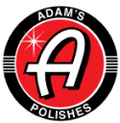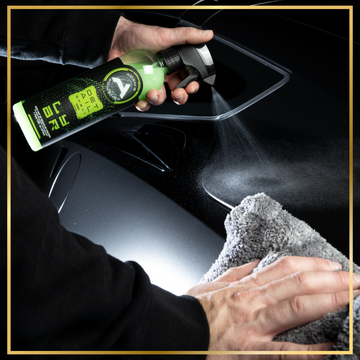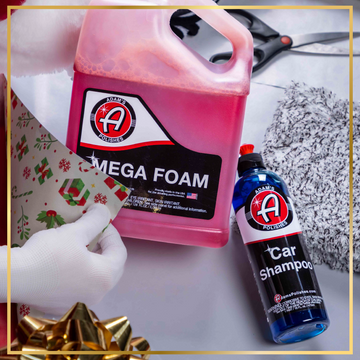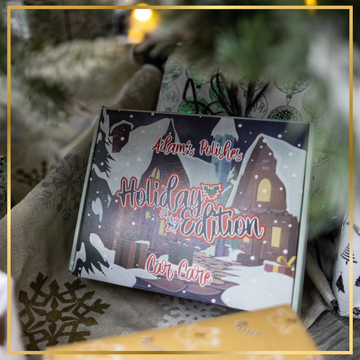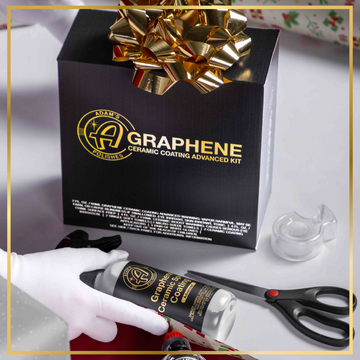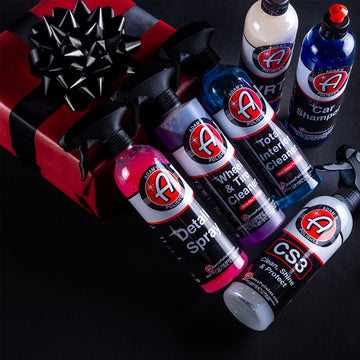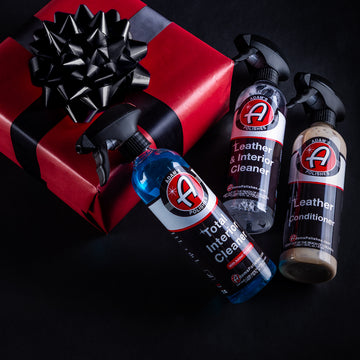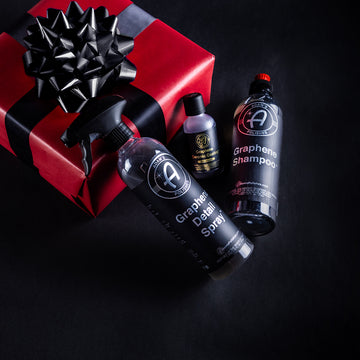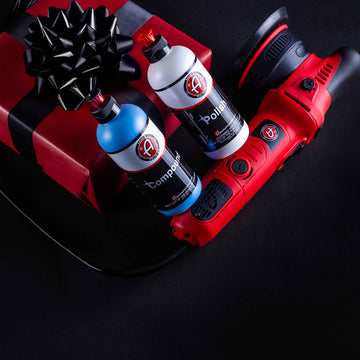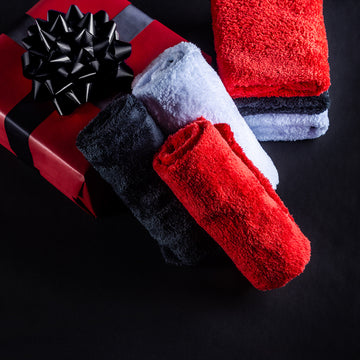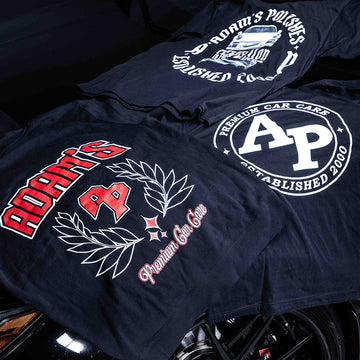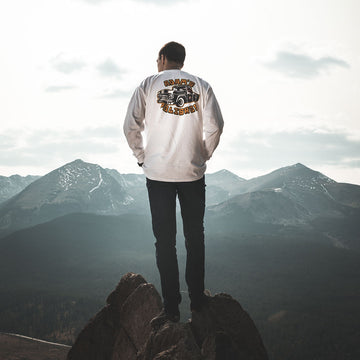Water spots are a reality that many car owners have to deal with, especially if your vehicle stays outside often. They’re annoying, detracting from your vehicle’s overall look, making paint less shiny. Water spots can stand out more easily on darker colored paints, glass, and even chrome trim pieces like side mirrors and bumpers. They can also lead to high levels of damage if left unaddressed, such as oxidation, etching, and eventual clear coat failure in some cases. There are several causes of water spots and how they develop. In this next article in our blog series, we’ll explain these causes, and more importantly, how to prevent them using the right products and processes. If water spots are already a reality on your vehicle, and you want to jump right into removal methods, CLICK HERE to learn about how to remove water spots
HOW TO AVOID
FROM GETTING
WATER SPOTS
Introduction
WATCH VIDEO BELOW TO LEARN HOW TO PREVENT FROM GETTING WATER SPOTS
In order to know how to prevent water spots, we first need to understand what they are and how they occur. Water spots occur when mineral deposits found in water droplets dry and evaporate onto a surface and leave a visible mark behind. Sometimes the water spot can appear as an outline of the water droplet, and other times it might be an entire irregular spot on the surface. You have most likely heard the terms “hard water” and “soft water” at some point in your lifetime.
Hard water usually contains magnesium, calcium, and iron deposits that can dry onto vehicle surfaces and leave spots behind. Two main sources of hard water exposure are sprinklers - whether you drive past them and your vehicle is sprayed, or you accidentally park near one and walk outside to find dried water on your car - and your water faucet and garden hose at your home. Some households will combat hard water with water softening systems. Soft water will remove the calcium and magnesium, but can have sodium deposits instead. Rainwater can also contain impurities that fall onto the vehicle surface and mix with dirt and dust particles that can then dry onto the surface and create water spots.
The more important factor of whether it is hard water or soft water causing the spots, is the Total Dissolved Solids (TDS) of the water, or in other words, the level of mineral deposits in the water. The higher the TDS number, the more water spots you will see on a surface. A TDS meter is a handheld device that will measure the conductivity of the dissolved ionized solids in water and provide a reading in Parts Per Million (PPM). Water can range from 50-1,000 ppm depending on the source - drinking water is typically in the 300-500 ppm range since it contains minerals like calcium and magnesium that are beneficial to your body, but not your vehicle’s paint. We’ll explain below what level you want your car washing water to be in order to eliminate water spots when washing your car.
Water Spots vs. Water Etching
If any of the above types of water spots are handled quickly enough, they can usually be removed without too much effort; however, if they are left unattended, or worse, if the water spots are then exposed to significant amounts of sunlight immediately after a wash or rainstorm, they can become etched into the clear coat, glass, or chrome, which will require much more effort to remove them. The minerals in the water can essentially become corrosive to the clear coat and cause chemical etching, where the water spots burn themselves into the clear coat, glass, etc. You can think of each water droplet as a tiny magnifying glass - the sunlight hits the water droplet, the temperature increases, and then it evaporates and etches into the surface. So how do we prevent these thousands of tiny blemishes? Let’s find out below.
WHAT CAUSES WATER SPOTS?
WATER SPOT PREVENTION
Now that we know the main causes of water spots, the next question is, how do you keep them from occurring? There are a few different ways to prevent water spots from developing and etching into the exterior surfaces of a vehicle. Next, we’ll cover proper washing methods, deionized water, and drying aids and protection products.
Proper Washing Methods
If you are washing your car on a sunny day or especially if you have hard water where you are washing, it is critical to follow a few key guidelines when washing:
-
Gather all washing materials first and have them ready. Prep your Soap and Rinse Buckets, optional Wheel Bucket with wheel and tire brushes, wash pads and mitts, drying towels, etc. The more you run back and forth during the wash process to grab things that you don’t have by your side, the longer hard water is sitting on the vehicle.
-
Wash in the early morning or evening if possible, to avoid the hottest part of the day.
-
Clean wheels, tires, fender wells, and exhaust tips first before putting any water to the vehicle. This will further reduce the amount of time that hard water sits on the paint and glass.
-
If washing in the morning or evening is not possible, rinse areas of the vehicle in the shade first, then areas in the sun last. This will reduce the amount of time that hard water is sitting on warm or hot surfaces.
-
Immediately after rinsing, begin to foam down the vehicle with a foam cannon or foam gun if you have one available, using one of our pH neutral soaps like Car Shampoo, Mega Foam, or Graphene Shampoo™. Foam down areas in the sun first, then areas in the shade, again to minimize the time that standing water dwells on warm or hot surfaces. The soap will attempt to neutralize the hard water to a degree.
-
Wash the exterior, cleaning your wash pad/mitt out frequently on the Grit Guard in the Rinse Bucket. Do not rinse the vehicle until you are done washing the entire exterior. It is better to let the soap residue dry onto the surface rather than let hard water sit on the surface. The soap residue will rinse clean even if it begins to dry.
-
As soon as you are done rinsing the vehicle, move it into the shade or garage if possible to dry it. Dry areas in direct sunlight first, then shaded areas last. Use a forced air dryer like the Adam’s Air Cannon Dryer or an Ultra Plush Drying Towel with a drying aid like Detail Spray (explained below) to reduce the chance of water spots while drying.
Deionized Water
An even better way to wash, and virtually eliminate water spots while drying, is to rinse the vehicle with deionized water. Deionized water removes nearly all minerals from the water, meaning that you can have a spot-free rinse and dry since there are near-zero minerals left in the water to cause water spots. A water deionizer like Adam’s Portable Spotless Water Deionizer can bring the TDS level of your water down to 0-40 ppm. A TDS reading of 25 ppm or less will allow for a spot-free rinse without the need to dry the vehicle. Our water deionizer also includes a bypass valve, so that you can use normal water for the pre-rinse and wash, and then switch to deionized water for the final rinse. This will let the resin in the deionizer last longer before you will need to replace it. On average, our standard deionizer filters up to 1,120 gallons of water with a TDS rating of 100 ppm (typical household) before replacing the resin.
Drying Aids and Protection Products
If a portable water deionizer is not in your detailing budget at the moment, using a drying aid during the drying process can greatly reduce or eliminate water spot formation as well. A drying aid is a spray-and-wipe product that you mist onto the wet vehicle surface after you have washed and rinsed the vehicle, when you are ready to begin drying all of the water off of the surface with a plush microfiber drying towel. Adam’s Detail Spray is our preferred spray product to use as a drying aid. By lightly misting Detail Spray on the wet surface, it will help to greatly slow down or eliminate water spotting by pulling water droplets together. A drying aid provides a more slick surface for your drying towel to glide over the surface easier while adding an extra boost of shine. It also allows the towel to absorb more water with less chance of scratching in the process. It is very streak-free and is compatible with waxes, sealants, ceramic, and graphene ceramic coatings. It is the perfect product to use for touch-ups in trouble areas as well, such as underneath side mirrors, gas caps, door handles, and lights, where excess water can drip out later, for example, if you open and close a door.
It’s important to discuss graphene ceramic coatings in terms of water spot prevention as well. Graphene Ceramic Coating™ and Graphene Ceramic Spray Coating™ will not completely prevent water spots from developing on the exterior surfaces of your vehicle; however, ceramic coatings create a very durable layer of protection above the clear coat, usually 2-3 times harder than the clear coat itself. Due to their hydrophobic nature, graphene ceramic coatings create thousands of tiny water beads on the flat surfaces of your vehicle after a rainstorm. With these tiny water beads being smaller than a normal raindrop or a larger puddle of water on a flat hood or sunroof, they typically will not act like a magnifying glass as much as larger water droplets can, so there is less chance they bake into the surface. When these small water beads do dry on the surface, you will notice they are much easier to clean off of a graphene ceramic coating - usually with just a spray and wipe of our Waterless Wash or Adam’s CS3. In other words, the ceramic coating provides a barrier to prevent the water spots from etching into the clear coat. Click Here for a write up with more information on our Graphene Ceramic Coating options.
Summary
We hope you now have an understanding of the causes of water spots, how they develop on a vehicle’s exterior surfaces, and some practices and products that will help to prevent them! In a separate Part 2 blog entry, How To Remove Water Spots, we’ll go over the different methods and processes on how to remove water spots if they are present on your car. If you are uncertain about any product or process, or have any questions in general, feel free to contact us at tips@adamspolishes.com, or reach us on our online communities on Adamsforums.com, Instagram, and facebook, as well.
